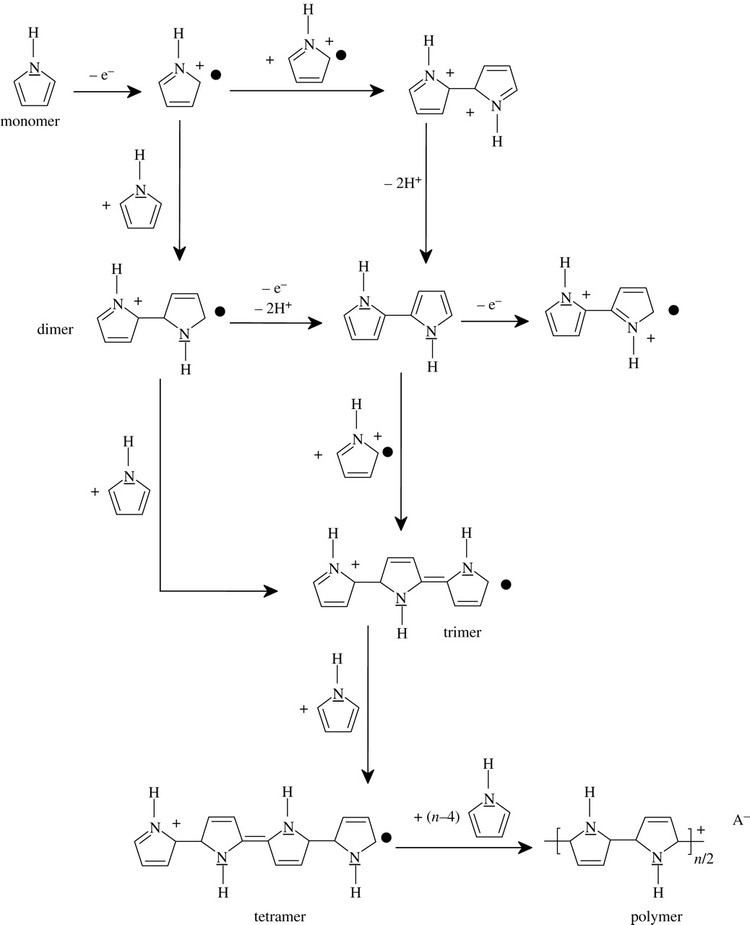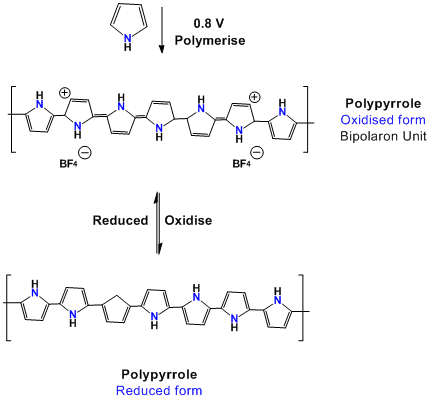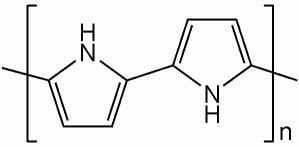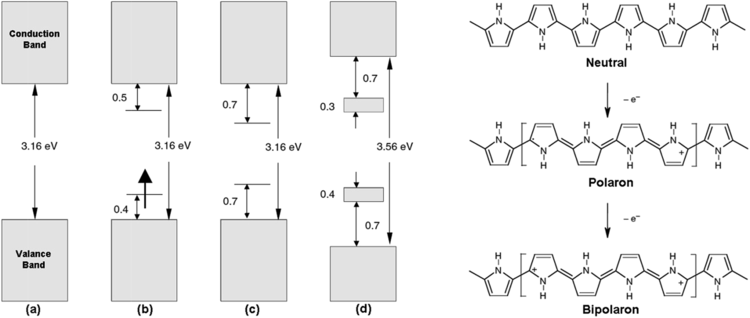 | ||
Similar Polyaniline, Polyacetylene, Polythiophene | ||
Polypyrrole
Polypyrrole (PPy) is a type of organic polymer formed by the polymerization of pyrrole. Polypyrroles are conducting polymers, related members being polythiophene, polyaniline, and polyacetylene. The Nobel Prize in Chemistry was awarded in 2000 for work on conductive polymers including polypyrrole.
Contents
- Polypyrrole
- New fast method for preparing high quality polypyrrole conducting polymer
- Synthesis
- Properties
- Applications
- Research trends
- References

New fast method for preparing high quality polypyrrole conducting polymer
Synthesis

Some of the first examples of polypyrroles were reported in 1963 by Weiss and coworkers. These workers described the pyrolysis of tetraiodopyrrole to produce highly conductive materials. Most commonly PPy is prepared by oxidation of pyrrole, which can be achieved using ferric chloride in methanol:
n C4H4NH + 2 FeCl3 → (C4H2NH)n + 2 FeCl2 + 2 HCl
Polymerization is thought to occur via the formation of the pi-radical cation C4H4NH+. This electrophile attacks the C-2 carbon of an unoxidized molecule of pyrrole to give a dimeric cation (C4H4NH)2]++. The process repeats itself many times.
Conductive forms of PPy are prepared by oxidation ("p-doping") of the polymer:
(C4H2NH)n + x FeCl3 → (C4H2NH)nClx + x FeCl2
The polymerization and p-doping can also be affected electrochemically. The resulting conductive polymer are peeled off of the anode. Cyclic voltammetry and chronocoulometry methods can be used for electrochemical synthesis of polypyrrole.
Properties
Films of PPy are yellow but darken in air due to some oxidation. Doped films are blue or black depending on the degree of polymerization and film thickness. They are amorphous, showing only weak diffraction. PPy is described as "quasi-unidimensional" vs one-dimensional since there is some crosslinking and chain hopping. Undoped and doped films are insoluble in solvents but swellable. Doping makes the materials brittle. They are stable in air up to 150 °C at which temperature the dopant starts to evolve (e.g., as HCl).
PPy is an insulator, but its oxidized derivatives are good electrical conductors. The conductivity of the material depends on the conditions and reagents used in the oxidation. Conductivities range from 2 to 100 S/cm. Higher conductivities are associated with larger anions, such as tosylate. Doping the polymer requires that the material swell to accommodate the charge-compensating anions. The physical changes associated with this charging and discharging has been discussed as a form of artificial muscle. The surface of polypyrrole films represent fractal properties and ionic diffusion through them show anomalous diffusion pattern.
Applications
PPy and related conductive polymers have two main application in electronic devices and for chemical sensors.
Research trends
PPy is a potential vehicle for drug delivery. The polymer matrix serves as a container for proteins.
Polypyrrole has been investigated as a catalyst support for fuel cells and to sensitize cathode electrocatalysts.
Together with other conjugated polymers such as polyaniline, poly(ethylenedioxythiophene) etc., polypyrrole has been studied as a material for "artificial muscles", a technology that offers advantages relative to traditional motor actuating elements.
Polypyrrole was used to coat silica and reverse phase silica to yield a material capable of anion exchange and exhibiting hydrophobic interactions.
Polypyrrole was used in the microwave fabrication of multiwalled carbon nanotubes, a rapid method to grow CNT's.
A water-resistant polyurethane sponge coated with a thin layer of polypyrrole absorbs 20 times its weight in oil and is reusable.
The wet-spun polypyrrole fibre can be prepared chemical polymerization pyrrole and DEHS as dopant.
